The Beat Goes On — Even 258 Miles Above Earth
April 30, 2020
At little after 3:30 p.m. EDT on April 7, 2020, the SpaceX Dragon spacecraft splashed down in the Pacific Ocean, returning to Earth after nearly a month attached to the International Space Station (ISS). The spacecraft brought back a number of physical and life sciences research projects, including heart and gut tissue chip projects that traveled to the ISS as part of the Tissue Chips in Space initiative.
Following this article, take a photo journey with the heart tissue chips as they traveled from Earth to the ISS and back.
The initiative is an ambitious collaborative endeavor that brings NCATS, the National Institute of Biomedical Imaging and Bioengineering and the ISS U.S. National Laboratory together to rapidly advance tissue chip technology for biomedical research. The chips contain miniature models of living tissues built from human cells. Because tissue chips accurately model the structure and function of human organs and systems, researchers could use them to predict — more quickly and effectively than current methods allow — whether a candidate drug, vaccine or biologic agent is safe or toxic in humans. Tissue chips also can provide new opportunities for researchers to study biological processes in the extreme environment of microgravity aboard the ISS.
Prolonged exposure to microgravity — as is experienced by the astronauts on the ISS — is known to cause changes to many aspects of the functioning of the human body, including in the heart and cardiovascular system. Many of the changes caused by microgravity look similar to those caused by accelerated disease and aging processes. Using tissue chips on the ISS provides a unique opportunity for researchers to model and study conditions related to diseases and aging over weeks or months, rather than the years that it would take for these conditions to develop on Earth.
Video of one of the heart tissues beating. The 3D heart tissue extends between two posts on a scaffold. The black square at the top is a magnet embedded in one of the posts. When the tissue contracts, a magnetic sensor detects the force of that contraction. (Jonathan Tsui)
A research team led by Deok-Ho Kim, Ph.D., at Johns Hopkins University and comprising researchers from several academic institutions and other organizations developed heart tissue chips to study the structural and functional changes to the tissue caused by spending time in low gravity. The team also developed related technology needed to send the tissue chips safely into space, survive on board the ISS for nearly a month and return to Earth. The researchers hypothesized that during that period of time the tissues would undergo functional, visible and molecular changes that are similar to those that occur with illness or old age on Earth.
Video of one of the heart tissues beating. The 3D heart tissue extends between two posts on a scaffold. The black square at the top is a magnet embedded in one of the posts. When the tissue contracts, a magnetic sensor detects the force of that contraction. (Jonathan Tsui)
To create the heart tissue chips, the researchers coaxed human induced pluripotent stem cells, which have the potential to become almost any type of cell in the body, to form cardiomyocytes (heart muscle cells) that developed into small 3-D structures between two posts on a silicon scaffold. One of the posts, which was flexible and bent each time the tissue contracted, contained a small magnet. While on the ISS, the magnet’s movements were picked up by a sensor and transmitted to the researchers on the ground so they could collect data on the strength of the contractions — and any changes to that strength — remotely.
Now that the tissue chips have returned to Earth, the researchers will continue to analyze the data they collected while the tissue chips were on the ISS and compare them to data from a set of comparison chips that remained on Earth. The research team also will begin to assess the visible and molecular changes the tissue may have undergone as a result of spending time in microgravity.
On a future flight, the researchers will test methods to improve heart cell contractions, including mechanical stimulation, which mimics muscle conditioning, as well as drugs known to protect the heart from an irregular heartbeat or heart disease. Findings from the project may have implications both for improving the health of astronauts and for finding new ways to study and treat heart diseases related to aging on Earth.
Follow the heart tissue chips' journey from Earth to space and back again by clicking the images below!

Heart tissues in one of the launch-ready chambers. Each chamber contains six individual tissues; a total of 48 tissues were sent to the International Space Station.
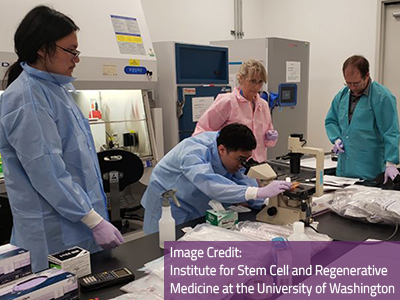
Ty Higashi of the University of Washington (left) and Stefanie Countryman and Paul Koenig of BioServe Space Technologies (back right) look on as Jonathan Tsui (center), also of the University of Washington, examines tissue chips in one of the launch-ready chambers through a microscope in the Space Station Processing Facility at Kennedy Space Center before the launch of SpaceX CRS-20.
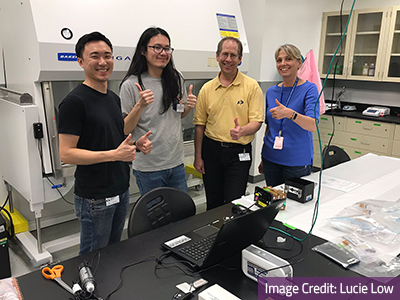
From left to right, Jonathan Tsui and Ty Higashi of the University of Washington and Paul Koenig and Stefanie Countryman of BioServe Space Technologies pose with the heart tissue chip hardware in the Space Station Processing Facility at Kennedy Space Center before the launch of SpaceX CRS-20.
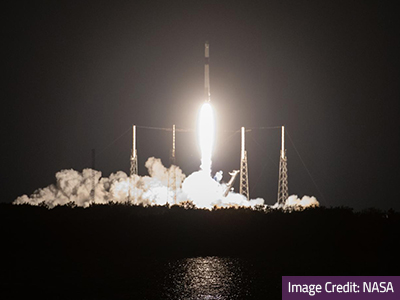
Just before midnight on March 7, 2020, SpaceX CRS-20 blasted off from Cape Canaveral Air Force Station in Florida. The Dragon spacecraft carried more than 4,300 pounds of cargo and science projects, including the heart tissue chip project.

After astronaut Jessica Meir used the International Space Station’s robotic arm to capture the SpaceX Dragon spacecraft on March 9, 2020, ground controllers remotely installed it on the Station’s Harmony module, where it stayed until its departure on April 7.

On board the International Space Station, astronaut Jessica Meir performed media exchanges on the chambers containing tiny, beating engineered heart tissues. The media exchanges removed waste and introduced new fluids to feed the cells.

Astronaut Jessica Meir holds a chamber containing heart tissue chips that traveled to the International Space Station (ISS) as part of the Tissue Chips in Space initiative. Studying tissue chips on the ISS gives researchers a unique opportunity to examine the effects of microgravity on human organs.

Six heart tissue chips beating on the International Space Station, 258 miles above the Earth.
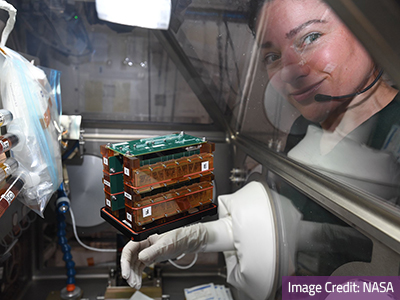
Sensors attached to the chambers containing the heart tissue chips detected changes in magnetic force as the tissues’ contractions moved posts with embedded magnets.
The data were transmitted back to Earth, allowing researchers on the ground to monitor the strength of the contractions while the experiment was on the International Space Station.
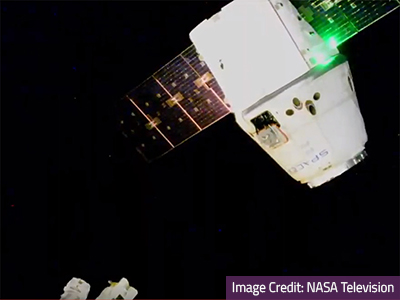
On April 7, 2020, the Space X Dragon capsule departed the International Space Station (ISS). It splashed down in the Pacific Ocean several hours later, returning the tissue chips and many other research projects and cargo to Earth.
The researchers will continue to study the data they collected while the chips were on the ISS and examine the tissues for visible and molecular changes.


